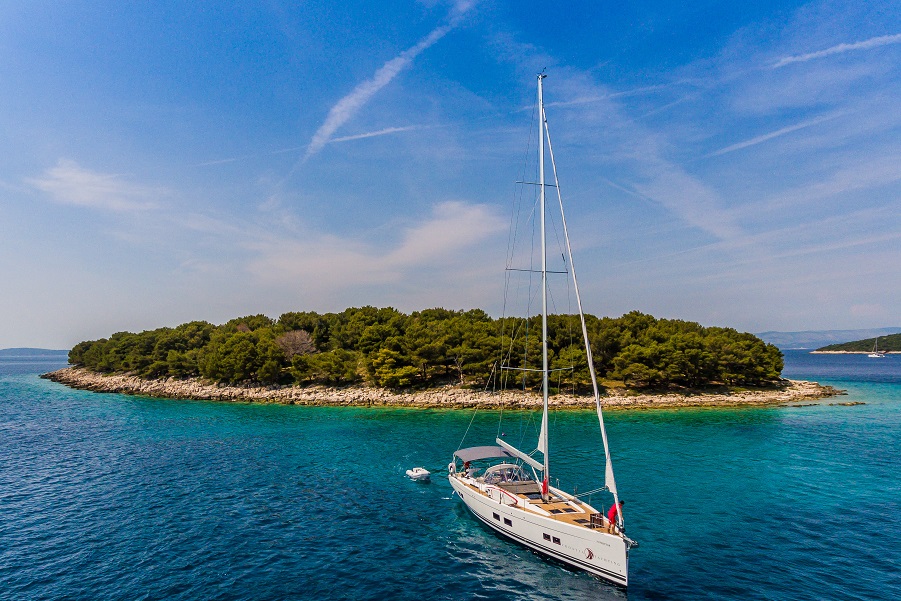Top 5 Mistakes in Skin Protection on a Boat And How to Avoid Them

Sailing offers unforgettable moments, but it also exposes your skin to intense environmental stress. Prolonged sun exposure, wind, and the strong reflection of UV rays off the water and deck make boaters especially vulnerable to sunburn, premature aging, and skin cancer. In this guide, we reveal the top 5 most common mistakes in skin protection on a boat—and how to avoid them. Learn how to choose the right sunscreen for boating, apply it effectively, and what to do if you get sunburned while out at sea.

Mistake 1: Not Applying Enough Sunscreen or Not Reapplying Often
Many boaters apply sunscreen only once a day or forget to reapply after swimming, sweating, or towel-drying. On a boat, where you are exposed to intense sun and UV reflection from the water, protection wears off quickly.
Sunscreen (SPF 30 or higher, water-resistant) should be applied 15–30 minutes before sun exposure and reapplied every two hours, especially after swimming or sweating. Don’t forget hard-to-reach areas: ears, neck, lips, feet, the backs of knees, and hands.
What is SPF and how to choose the right sunscreen?
SPF (sun protection factor) indicates the level of protection against UVB rays, which cause sunburn and increase the risk of skin cancer. The higher the SPF number, the longer and stronger the protection.
SPF tells us how long the product protects our skin from UVB radiation:
- SPF 15: blocks 93% of UVB rays
- SPF 30: blocks 97% of UVB rays
- SPF 50: blocks 98% of UVB rays
- SPF 100: blocks 99% of UVB rays
Dermatologists recommend using sunscreens with at least SPF 30, and the number should be adjusted to your skin type and planned sun exposure. Always choose broad-spectrum sunscreens that protect against both UVA and UVB rays. UVB ("B" for "burns") rays are shorter wavelength and reach the surface layer of the skin. These rays are responsible for tanning, but also for sunburn. On the other hand, UVA ("A" for "aging") rays are longer wavelength and penetrate deeper into the skin, causing lasting damage such as skin aging.
Mineral vs. chemical filters – differences and advantages
Sunscreens differ by the type of filters they use. Mineral (physical) filters contain zinc oxide or titanium dioxide. They reflect UV rays from the skin’s surface, work immediately after application, cause less irritation, and are suitable for children and sensitive skin. Their downside is that they can leave a white cast and have a thicker texture.
Chemical filters absorb UV rays and convert them into heat. They spread easily, don’t leave white marks, and are often more water-resistant, but need to be applied 15–20 minutes before sun exposure. For sensitive skin, chemical filters can sometimes irritate.
Choose your sunscreen based on your skin type, planned activities, and personal preferences-the most important thing is to use one you will apply regularly.
Mistake 2: Trusting the Wind and Sea Breeze for Sun Protection
On a boat, the breeze and sea spray often make you feel pleasantly cool, so you may not notice your skin is burning. Wind and water do not reduce UV radiation-in fact, reflection from the sea and white decks increase exposure.
Do not rely on how you feel; instead, stick to a schedule and protective measures. Avoid the sun during peak hours (10 am–3 pm), plan activities in the shade or under a bimini, and wear UV-protection sunglasses and a wide-brimmed hat.
It is especially important to know that in water, UV exposure increases by about 90%. Many people forget that water does not protect from UV rays. On the contrary, water amplifies UV rays by about 90%. Even one meter below the surface, UV rays still reach the body. In addition, 80% of long-wave UVA rays, which cause premature skin aging and wrinkles, reach the water. Of the short-wave UVB rays, which typically cause sunburn, about 50% reach the water.

Mistake 3: Forgetting to Wear Protective Clothing and Accessories for Sun Safety
Many people think that short sleeves or regular shirts are enough, but standard clothing often does not provide sufficient UV protection. Invest in clothing with a high UPF (ultraviolet protection factor), ideally UPF 50+-lightweight, long sleeves, long pants, and hooded shirts.
UPF indicates how much UV radiation (both UVB and UVA) a fabric allows to reach your skin. For example, UPF 50 fabric blocks 98% of the sun’s rays and allows only 2% (1/50th) to penetrate, significantly reducing the risk of exposure.
Wear a wide-brimmed hat and UV-protection sunglasses, use buffs or scarves for your neck and ears, and always have spare protective clothing on board. Fabrics with UPF 50+ provide excellent protection, while UPF 30 to 49 offers very good protection.

Mistake 4: Forgetting protection in the shade or on cloudy days
Many believe that being under a bimini, canopy, or on a cloudy day is enough protection. However, UV rays penetrate clouds, and reflection from the sea and deck can burn you even in the shade.
Even on cloudy days, the sun still emits UV light that penetrates clouds and can result in sunburn. Over 90% of UV rays can pass through a light cloud cover and cause burns. Studies have shown that partly cloudy skies can increase UV-B rays by 25% and increase DNA damage by up to 40%! So, cloudy days can be more dangerous for your skin.
Under a canopy or bimini, always use sunscreen and protective clothing. Don’t relax on cloudy days radiation is still present.
Mistake 5: Skipping Post-Sun Hydration and Skin Care
Sun, wind, and salt dry out the skin, and dehydration increases the risk of damage and slows recovery. Drink water regularly, even if you’re not thirsty-aim for at least two liters a day, more if you’re active or it’s hot.
After a day in the sun, shower with fresh water and apply a moisturizing cream or aloe vera gel. When you spend time in the sun, your skin can become dry, irritated, and red, indicating the need for special treatment.
The first step in skin care after sun exposure is hydration. After showering, it is important to gently dry the skin by patting it with a towel, avoiding rubbing which can irritate sensitive skin. For proper care, it is necessary to apply a quality moisturizing lotion or cream.
Avoid alcohol and caffeine, which further dehydrate the body. Regularly check your skin for changes and consult a dermatologist if you notice unusual changes, moles, or wounds that do not heal.
SOS: What to Do if You Get Sunburned?
If you do get sunburned, it’s important to act quickly to relieve symptoms and prevent complications:
- Move out of the sun immediately and seek shade or go indoors.
- Cool your skin with lukewarm or cool water (not ice-cold!), by taking a shower or using compresses. Change compresses every 15 minutes.
- Apply moisturizing creams or gels, especially those with aloe vera, which cool and soothe the skin. Avoid products containing alcohol.
- Drink plenty of water to prevent dehydration and help your skin recover faster.
- Wear light, loose, breathable cotton clothing, or if you’re at home, avoid clothing to reduce irritation.
- Avoid further sun exposure until your skin has healed, which may take several days.
- To relieve pain, you can use medications such as paracetamol (acetaminophen) or ibuprofen.
- If you develop blisters, severe pain, or signs of infection, be sure to consult a doctor.
Additional Useful Tips For Safety On a Boat
- Prepare in advance: Get enough protective products before your trip (sunscreen, clothing, hats, sunglasses).
- Reminders: Set an alarm on your phone to remind you to reapply sunscreen.
- Protecting children: Children are especially sensitive-use children’s sunscreen with high SPF and always dress them in protective clothing and hats.
- Besides the face, don’t forget to apply SPF to your neck, jaw, hands, and all other exposed areas. It is very important to regularly renew protection, especially if you are in the sun for a long time.
Protecting your skin on a boat requires more than just the occasional sunscreen application. A combination of proper use of protective products, suitable clothing, activity planning, and hydration will keep you healthy and allow you to fully enjoy your time at sea. Don’t underestimate the power of the sun on the water skin will thank you for every extra precaution you take.
















